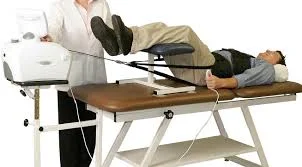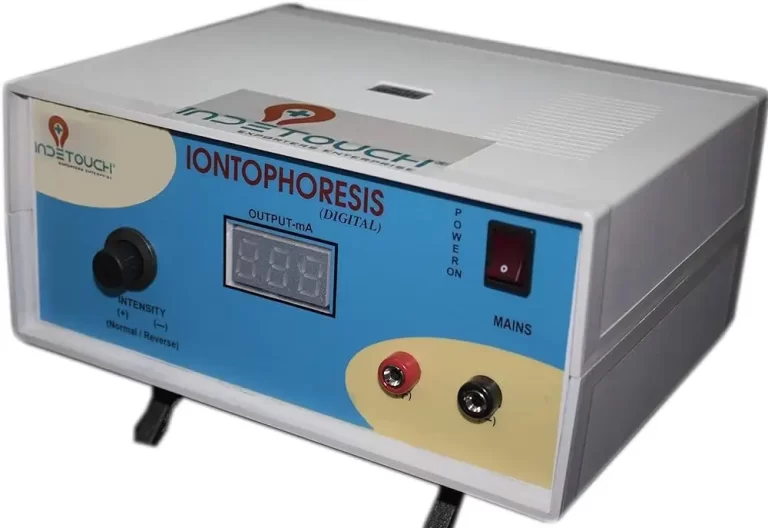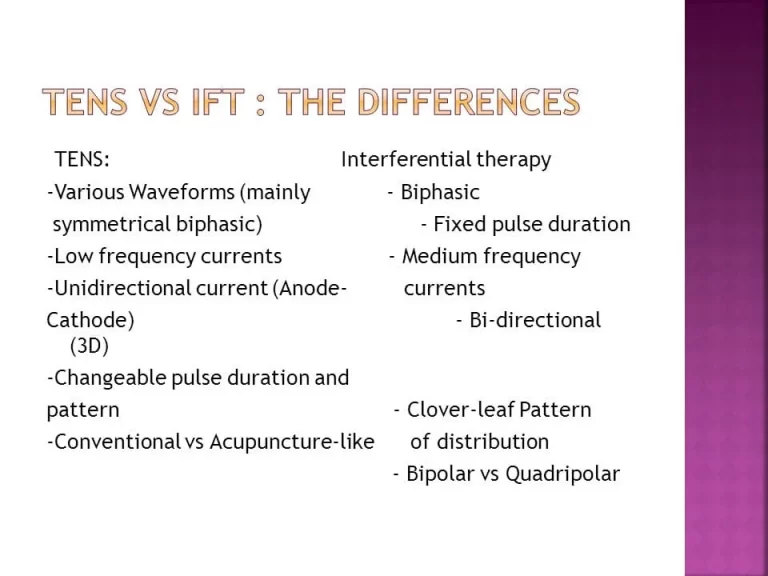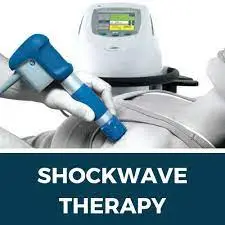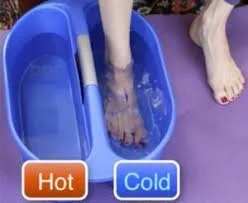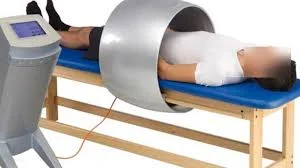Lumbar Traction
What is Lumbar Traction?
Lumbar traction is a therapeutic technique used to relieve pain and improve function in individuals suffering from lower back conditions, particularly those involving compression or irritation of the spinal structures.
This non-invasive treatment involves applying a pulling force to the spine to create a separation between the vertebrae, which can help alleviate pressure on the spinal discs, nerves, and other structures.
Definition:
Lumbar traction is the process of delivering force to the lumber vertebra by the use of pulleys and weight to distract the lumber joints.
The name “traction” comes from the Latin word “tractico” which means “a drawing or pulling” and several types of spinal traction have been used to cure back pain since Hippocrates’ time (about 460-377 BC).
James Cyriax popularised lumbar traction in the 1950s and 1960s for the treatment of disc prolapse (PIVD), but it is still used today as a frequent method for the treatment of low back pain and sciatica pain.
However, the efficacy of lumbar traction has been called into question in a few medical trials, and recent guidelines released by NICE in the UK, KCE in Belgium, The Danish Health Administration, and the American College of Physicians no longer recommend traction as a treatment option for low back pain.
James Cyriax explains the three benefits of lumbar traction:
To enhance intervertebral space, lengthen the posterior longitudinal vertebral ligament and apply horizontal stress to the rear of the joint.
Suction moves the prolapsed disc towards the center of the joint. Other benefits of lumbar traction include enlarging the intervertebral foramen, distracting the apophyseal joints, and improving the body’s ability to recover itself.
Clinically relevant anatomy:
The concave lumbar curvature in the lower back is generated by five distinct vertebrae of the lumbar spine (numbered L1-L5). The lumbar vertebrae are located in the spine below the thoracic vertebrae and above the sacrum and coccyx in the pelvis. It is situated in the lumbar (lower back) area of the body, near the midline. These vertebrae sustain the full upper body weight while also allowing for flexibility and mobility in the trunk region.
Each vertebra is connected to its neighbor by an intervertebral disc made of rigid fibrocartilage with a jelly-like center. The annulus fibrosis, or outer layer of the intervertebral disc, binds the vertebrae together while also providing strength and flexibility to the back during movement. The jelly-like nucleus pulposus acts as a shock absorber, allowing the lower back to bear pressure and strain.
The lumbar vertebrae could be the biggest and most heavily in the spine, second only to the sacrum. The vertebral body, a cylinder-shaped bone, bears the majority of the weight of the body on the lumbar vertebrae. The body links to the arch, which is a narrow bone ring, posteriorly. The arch protects the enlarged vertebral foramen and links the body to the bony processes at the back of the vertebra. The spinal cord, cauda equina, and meninges can travel through the lower back via the vertebral foramen, a big triangular aperture in the center of the vertebrae.
Several bony structures extend from the vertebral arch and are responsible for muscle attachment and lower back mobility. The spinous cycle extends from the back end of the curve in the shape of a fragile square bone. The muscles of the back and pelvis, such as the psoas major and interspinal, come together at this position. The short, triangular transverse processes are found on each vertebra’s left and right lateral surfaces. The rotatores and multifidus muscles, which stretch and rotate the trunk, rely on the transverse processes for attachment.
The lumbar vertebrae, unlike the cervical vertebrae in the neck, do not have facets on each side of the body or transverse foramina in the transverse processes. Unlike the L1-4 vertebrae, the L5 vertebrae are much bigger on the front side than the rear. On the other hand, it has a larger, four-sided form, a rough edge, and a deep notch on its spinous process, which is smaller than the other lumbar vertebrae.
Mechanism of Traction therapy:
Traction therapy’s therapeutic benefits have been hypothesized to have many mechanisms. Distracting the motion segment should change the location of the nucleus pulpous relative to the posterior annulus fibrosis or the disc-nerve contact. These effects might be attributed to studies on the kinematics of the lumbar spine during traction therapy. In addition to separating the vertebrae, footing has been shown to reduce core pulposus pressure and expand the foraminal area.
In any case, any mechanical changes detected in a downward position cannot be maintained after the patient adopts an upright, weight-bearing stance. The traction’s influence on the motion segment’s mechanobiology or neural tissues is more likely to be responsible for any long-term clinical response. The fact that not all traction treatments perform the same way on the spine, as well as animal research demonstrating that the disc’s mechanobiology is sensitive to the amount, frequency, and duration of loading, complicates the problem.
Some traction methods may promote tissue degeneration, whereas others may aid in the healing of discs or joints. Even though these characteristics have not been studied systematically, even in animal models, what we know about disc mechanobiology shows that not all traction treatments are the same. If diverting the spine affects plate and joint mechanobiology, different footing strategies may provide different clinical results.
The possibility of different effects based on force and time parameters has not been considered in the majority of lumbar traction treatment systematic studies. Patients with a combination of clinical manifestations, such as leg-dominant LBP, back-dominant LBP, or both, have frequently taken part in traction studies.
In any instance, a patient with just prevailing LBP and no radiculopathy is more likely to experience pain from a sclerotome source, such as feature joints or plates, but sciatic pain, regardless of whether caused by circle herniation, may prevail in the brain. Although there is inadequate data to support this theory, it is logical to expect that traction therapy will affect various illnesses in distinct ways.
Interruption control and positional interruption are not the same as conventional footing (continuous or supported). These therapies seek to concentrate pressures in a limited location rather than spreading them across the lumbar tissues. For example, AT allows the patient to concentrate the force by diverting themselves in the position that causes them the least discomfort. The majority of chiropractors and physical therapists utilize distraction manipulation, which is done on treatment tables that allow the operator to control the direction and time of the distractive force.
Types of Lumbar Traction:
There are 7 forms of lumbar traction, as listed below.
Continuous Traction
- it is used to temporarily immobilize a symptomatic spinal region.
- A modest force (4.5 to 9 kg) is delivered over an extended length of time (hours to days).
- However, this method of applying traction is rarely employed since individuals with spinal pain do not benefit from extended bed rest and inactivity.
Sustained traction
- it requires more effort than continuous traction.
- The pull is maintained for 20 to 60 minutes.It is quite effective when used on a split traction table.
Intermittent Traction
- This type of traction enables higher forces to be applied for a brief duration.
Throughout each cycle, the force progressively increases and decreases. - Ex: 7 to 10 seconds of tractional force followed by 5 seconds of rest, up to 30 to 60 seconds of tractional force followed by 10-15 seconds of rest.
The overall duration of the on-and-off cycle is 15 to 25 minutes.
Manual Traction
- The therapist applies traction directly to the patient’s legs using a belt.
- It is typically used for a few seconds or as a fast, rapid thrust.
Auto Traction
- It will use a specifically constructed table. It consists of two pieces that may be separately tilted and rotated.
- The traction force is applied to the patient by pulling the arms or pressing the feet.
Positional Traction
- As the name implies, tractional force is applied through numerous postures.
- Traction force is applied by positioning the patient in various postures and utilizing cushions, blocks, or weight coughs to exert a draw on spinal tissues.
Gravity Assisted Lumbar Traction
- A chest strap secures the patient to the treatment table, which is inclined vertically. The weight of the lower part of the body provides traction to the body.
Uses and indications of lumber traction:
- Herniated Disc: Lumbar traction can give comfort by relieving pressure on the herniated disc material, which could relieve radiating pain and neurological problems.
- Degenerative Disc Disease: Traction may aid in degenerative disc disease, in which the discs lose height and flexibility, resulting in discomfort and reduced motion.
- Sciatica: Traction can assist relieve compression on the sciatic nerve, which causes pain to radiate down the leg.
- Spinal stenosis: it occurs when the spinal canal narrows, causing nerve compression. Traction might momentarily reduce the compression and discomfort.
- Facet Joint Dysfunction: Traction can relieve pressure on the facet joints, which are tiny joints that aid in spinal mobility. Dysfunction can cause discomfort and impaired mobility.
- Muscle Spasms: Traction can assist relax muscles surrounding the lumbar spine, therefore decreasing muscular spasms and discomfort.
- Chronic Lower Back Pain: TractionTraction may reduce pressure on afflicted tissues and induce muscular relaxation in cases of nonspecific lower back pain.
Contraindications of lumber traction:
Many conditions do not allow for traction on the lumbar spine. Before prescribing traction for back pain, the physical therapist must first get a thorough medical history.
- Acute strains.
- Sprains
- Inflammation
- Respiratory problem.
- Claustrophobia
- Conditions include osteoporosis and infection.
- Tumour
- Rheumatoid arthritis.
- Pregnancy
- Cardiovascular illness.
- Hernia
- Cauda equina syndrome
- Neoplasms
- Pott’s Disease
- All inflammatory disorders of the vertebrae
- Heart or circulation disease
- Severe respiratory issues
- Post-operative patients after three months of back surgery
- Vertebral fracture within 6 months after first injury. Fusion with internal fixation.
Benefits of Traction Therapy:
Traction Therapy can effectively cure chronic neck and spinal cord pain.
Muscle relaxation
The difficulty is that the location of the spinal column causes excessive tension in the muscles. As a result, the muscles are always under tension. Traction, on the other hand, can help relax and reduce muscular tension.
Pain alleviation
The applied force allows for the controlled straightening of the spinal column. It will ease the pressure that may otherwise cause pain. It will also create a healthier physical environment, hastening the healing process.
Avoid surgery
You can simply avoid surgical treatments by utilizing mechanical pain management and spinal realignment. The therapist or machine will provide the necessary force.
Promotes complete healing
Accurate pressure on the disc releases healing nutrients, activating your body’s natural healing process. Of course, it will result in a faster total recovery.
It complements other therapies
The treatment does not need any surgery. As a consequence, further therapies such as heat and cold therapy, electric stimulation, and ultrasonic treatments are completely safe.
The entire treatment is considered minimally invasive. However, you may only get the benefits if you undergo the operation with novice practitioners who have the necessary knowledge and awareness to perform mechanical or manual therapies.
What does traction therapy feel like?
Traction therapy is a therapeutic approach for relieving pressure on the spine or other sections of the musculoskeletal system. Here’s an overview of what traction treatment feels like:
Stretching effect: During traction therapy, patients frequently notice a mild stretching sensation in the targeted area. By decompressing the spine or joints, this stretching relieves tension and promotes relaxation.
Soothing: Traction therapy is calming for many patients because it relieves muscle tension and promotes blood flow to the affected area.
Mild Difficulty: Although traction therapy is generally well tolerated, some patients may have minimal soreness or discomfort during or following the procedure. This is particularly likely to occur if the traction force is applied incorrectly or with excessive force.
How Do I Prepare for Lumbar Traction?
Traction is administered using a mechanized device that utilizes a pelvic and thoracic belt.
This belt is placed directly on the patient’s skin rather than over their clothes. Both belts should be properly adjusted to avoid slippage.
Thoracic belt placement :
it involves aligning the bottom edge with the maximum limit of needed traction force.
The top margin was almost aligned with the xiphoid directly below the largest diameter of the thorax.
Pelvic belt placement :
it involves aligning the superior edge with the intended inferior limit for traction force.
Supine posture, just superior to the iliac crest.
The prone posture is superior to the superior edge of the sacrum.
The machine has two parts: fixed and mobile and a lower body that sits on the mobile unit separates from the fixed unit when a tactile force is applied.
Colachis and Strohm discovered that with the hips flexed 70 degrees and an angle of pull of 18, the largest spinal separation is achieved.
Positioning:
Supine posture is preferred for separating posterior parts and directing traction force to the upper lumbar and thoracic regions.
How Do I Calculate Weight in a Lumbar Traction Machine?
The Lumbar Traction Machine’s weight is calculated using the following parameters.
Traction parameters:
(1) Acute phase:
force ranges from 13 to 20 kg.
Hold/relax Equals static
for 5-10 minutes
(2)Joint distractions:
Force equals 50% of body weight.
Hold/relax for 15 seconds
a length of 20-30 minutes.
(3) To reduce spasms:
apply a force of 25% of body weight
hold/relax for 5 seconds each.
duration=20 to 30 mints
(4) Disc problems (soft tissue stretching).
Force: 25% of body weight
Hold/Relax: 60/20 seconds
duration=20 to 30 mints
What are the possible negative effects of lumbar traction?
While traction therapy appears to be safe for most people, there are some possible bad effects:
muscular Spasms: Traction therapy can produce muscular spasms in some persons, especially if the force is too intense or applied improperly.
pain: Some patients may have temporary pain or discomfort in the treated area following traction therapy.
Nerve Irritation: In rare situations, traction therapy might exacerbate nerve disorders in certain persons, causing further pain or suffering.
Skin Irritation: The traction device may produce slight skin irritation or redness in the contact areas.
What are the risk factors for the lumbar traction?
- Lumbar traction isn’t for everyone. As a result, the physical therapist determines if the risk is higher depending on the patient’s medical history.
- There is no long-term danger from lumbar traction.
- Some adverse effects may appear during or during the therapy session.
- Some people may experience discomfort in the treatment location.
What is the prognosis following spinal traction?
- Many people succeed and attain their goals thanks to physical treatment. Treatment relieves discomfort and allows the body to repair itself.
- Some patients require traction therapy for a short length of time, while others may need it for the rest of their lives.
How can I do self-lumbar traction?
The objective of traction is to alleviate or eliminate your discomfort. Here are various strategies for self-lumbar traction.
Back lying matters pull: Lie on your back with both legs bent. Grab the edge of the mattress and gently pull to establish traction.
Stand between two chairs: with your hands on the backs. To unload your back, keep your arms straight and bend your legs.
Lumbar traction kit at home:
A lumbar traction kit can help treat low back discomfort at home.
The lumbar traction package contains:
- Backboard Straps Weights
- Traction pully
- Pelvic belt: It firmly supports the pelvic area without causing discomfort, and the two side belts offer traction in the legs’ parallel direction.
- Spreader bar and hook
- Spreader bar: It supports the traction belt and flexibly manages the pulley rope during movement.
- Three-meter-long rope
- Water bag: It is comprised of a robust material that retains the needed weight to provide traction.
How to use a Lumbar Traction Kit?
- Use your Traction pulley bracket to swing on the bed’s leg side.
- Then, measure your waist circumference and pick a size based on the table presented in the video.
- Place the lumbar belt below your waist and loop it around.
- The hook connects both pelvic belts to the spreader bar.
- Tie the traction cable to the hook of the spreader bar and run the other end through the pully.
- Secure the traction cord to the water-weight bag.
- The therapist carefully calculates the weights taking into account the patient’s age, weight, and illness. It is generally one-eighth of the body weight.
How do I remove the traction kit?
- Remove the weight bag.
- Release the traction cable from the spreader hook.
- Release the belts.
Several brands sell it online:
Tynor lumbar traction kit: Its exceptional design ensures long-lasting performance and precise application of traction force. It is the optimal solution for obtaining the intended goals. It will help you recover from neck and back discomfort. The cost of this kit fluctuates between Rs 1500 and Rs 6000.
Flamingo Lumbar Traction Kit: This kit is also used for orthopedic purposes. It is not only a high-quality product, but it also provides an unequaled answer for individuals suffering from orthopedic issues. More effective relief may be obtained swiftly and comfortably, without causing discomfort or agony. The price ranges from Rs 1200 to Rs 4500.
Vissco traction kit: It is a trustworthy manufacturer of traction kits. It provides superior quality and performance. Lumbar traction kit prices range from Rs 1000 to Rs 4000.
Summary
Lumbar traction is a feasible therapy for many musculoskeletal issues. The delivery of successful medication is not as simple as it appears. There are different interpretations of the approach, some of which have doubtful validity.
The physical therapist who plans to treat patients with spinal traction should get familiar with the most effective treatments and how to use them. Finally, the value of a musculoskeletal examination cannot be emphasized. If the information acquired during the examination is wrong, the treatment plan has a low likelihood of success.
FAQs
Does walking lessen disc bulge?
In general, exercise is OK as long as it is done appropriately. Core and back workouts, as well as walking, elliptical exercise, swimming, and riding a stationary or conventional bike, can aid with bulging discs.
What is the purpose of traction therapy?
Traction treatment is designed to ease pain, reduce pressure, and enhance the spine’s range of motion and flexibility.
Is lumbar traction a lasting solution?
Lumbar traction gives brief comfort by alleviating pain and aiding recovery. To treat the underlying cause, lifestyle modifications, and other therapy should be implemented as prescribed.
How long should you apply lumbar traction?
The usual traction regimen consists of applying a force equal to 50% of the patient’s body weight and an intermittent force pattern of 20 to 30 seconds on and 10 to 15 seconds off for a total of 15 minutes.
Is lumbar traction safe?
Traction is not a danger in the long run. There may be some negative effects during or after therapy. Many patients have muscular spasms following traction, as well as discomfort in the treated region.
Is traction effective for sliding discs?
Finally, lumbar traction improves the symptoms and clinical findings of lumbar disc herniation patients while decreasing the size of the determined CT herniated disc material.
Can traction induce nerve damage?
Although halo-suspension or halo-wheelchair traction may be slightly stiff, damage to the hypoglossal nerve might occur when traction exceeds 40% of the body weight.
References
- Hospitals, M. (n.d.). Understand the Lumbar Traction: Definition, Uses, and Treatment. Best Hospitals in India | Medicover Hospitals. https://www.medicoverhospitals.in/articles/lumbar-traction-treatment
- Physiotattva. (n.d.). Effective Traction Therapy at Physiotattva. PhysioTattva. https://www.physiotattva.com/therapies/traction-therapyCopy
- Chauhan, S. (2023, November 11). Lumbar Traction for Low Back Pain : Benefits, Indication. Mobile Physiotherapy Clinic. https://mobilephysiotherapyclinic.in/lumbar-traction-for-low-back-pain-benefits-indication-and-contraindication/
- What is Traction Therapy? What conditions are treated by Traction Therapy? Who will benefit from Traction Therapy? (n.d.). cbphysiotherapy. https://cbphysiotherapy.in/therapies-offered/traction-therapy
- Sankhla, D., & Sankhla, D. (2023, April 7). Lumbar traction – Type, Mechanism, Indication, Contraindications. Samarpan Physiotherapy Clinic. https://samarpanphysioclinic.com/lumbar-traction/

